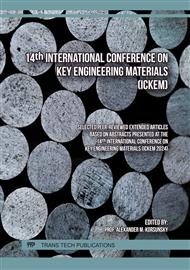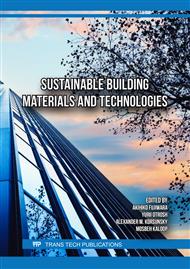[1]
X. Jiang, D. Guan, Determinants of global CO2 emissions growth, Applied Energy 184 (2016) 1132–1141.
DOI: 10.1016/j.apenergy.2016.06.142
Google Scholar
[2]
C. Chen, G. Habert, Y. Bouzidi, A. Jullien, Environmental impact of cement production: Detail of the different processes and cement plant variability evaluation, Journal of Cleaner Production 18(5) (2010) 478–485.
DOI: 10.1016/j.jclepro.2009.12.014
Google Scholar
[3]
E. Belhadj, C. Diliberto, A. Lecomte, Characterization and activation of Basic Oxygen Furnace slag, Cement and Concrete Composites 34(1) (2012) 34–40.
DOI: 10.1016/j.cemconcomp.2011.08.012
Google Scholar
[4]
W.F. Santos, K. Schollbach, S. Melzer, S.R. van der Laan, H.J.H. Brouwers, Quantitative analysis and phase assemblage of basic oxygen furnace slag hydration, Journal of Hazardous Materials 450 (2023) 131029.
DOI: 10.1016/j.jhazmat.2023.131029
Google Scholar
[5]
S.C. Zago, F. Vernilli, O. Cascudo, The Reuse of Basic Oxygen Furnace Slag as Concrete Aggregate to Achieve Sustainable Development: Characteristics and Limitations, Buildings 13(5) (2023) 1193–1193.
DOI: 10.3390/buildings13051193
Google Scholar
[6]
Q. Wang, D. Wang, S. Zhuang, The soundness of steel slag with different free CaO and MgO contents, Construction and Building Materials 151 (2017) 138–146.
DOI: 10.1016/j.conbuildmat.2017.06.077
Google Scholar
[7]
T.H. Su, H.J. Yang, Y.H. Shau, E. Takazawa, Y.C. Lee, CO2 sequestration utilizing basic-oxygen furnace slag: Controlling factors, reaction mechanisms and V–Cr concerns, J. Environmental Sciences 41 (2016) 99–111.
DOI: 10.1016/j.jes.2015.06.012
Google Scholar
[8]
R.M. Cuéllar, Adisa Azapagic, Life Cycle Environmental Impacts of Carbon Capture, Storage, and Utilization, Encyclopedia of Sustainable Technologies (2017) 447–459
DOI: 10.1016/B978-0-12-409548-9.10123-X
Google Scholar
[9]
M. Ma, H. Mehdizadeh, M.-Z. Guo, T.-C. Ling, Effect of direct carbonation routes of basic oxygen furnace slag (BOFS) on strength and hydration of blended cement paste, Construction and Building Materials 304 (2021) 124628.
DOI: 10.1016/j.conbuildmat.2021.124628
Google Scholar
[10]
M. Auroy, S. Poyet, P. Le Bescop, J.-M. Torrenti, T. Charpentier, M. Moskura, X. Bourbon, Comparison between natural and accelerated carbonation (3% CO2): Impact on mineralogy, microstructure, water retention and cracking, Cement and Concrete Research 109 (2018) 64–80.
DOI: 10.1016/j.cemconres.2018.04.012
Google Scholar
[11]
V.L.M. Molahid, F. Mohd Kusin, S.N.M. Syed Hasan, N.A.A. Ramli, A.M. Abdullah, CO2 Sequestration through Mineral Carbonation: Effect of Different Parameters on Carbonation of Fe-Rich Mine Waste Materials 10(2) (2022) 432.
DOI: 10.3390/pr10020432
Google Scholar
[12]
G. Ferrara, A. Belli, A. Keulen, J.-M. Tulliani, P. Palmero, Testing procedures for CO2 uptake assessment of accelerated carbonation products: Experimental application on basic oxygen furnace steel slag samples, Construction and Building Materials 406 (2023) 133384.
DOI: 10.1016/j.conbuildmat.2023.133384
Google Scholar
[13]
J.K. Chetri, K.R. Reddy, D.G. Grubb, Effect of Moisture Content on CO2 Sequestration by BOF Slag in Landfill Cover, Geo-Congress (2019).
DOI: 10.1061/9780784482148.016
Google Scholar
[14]
H.H. Steinour, Some effects of carbon dioxide on mortars and concrete-discussion, Journal of the American Concrete Institute 30 (1959) 905–907.
Google Scholar



